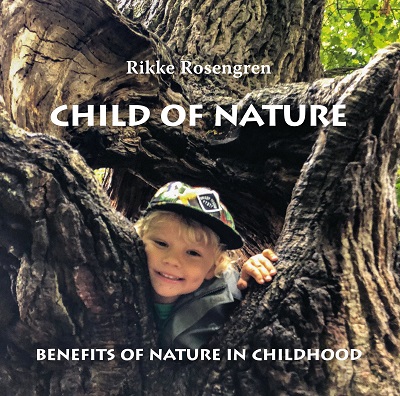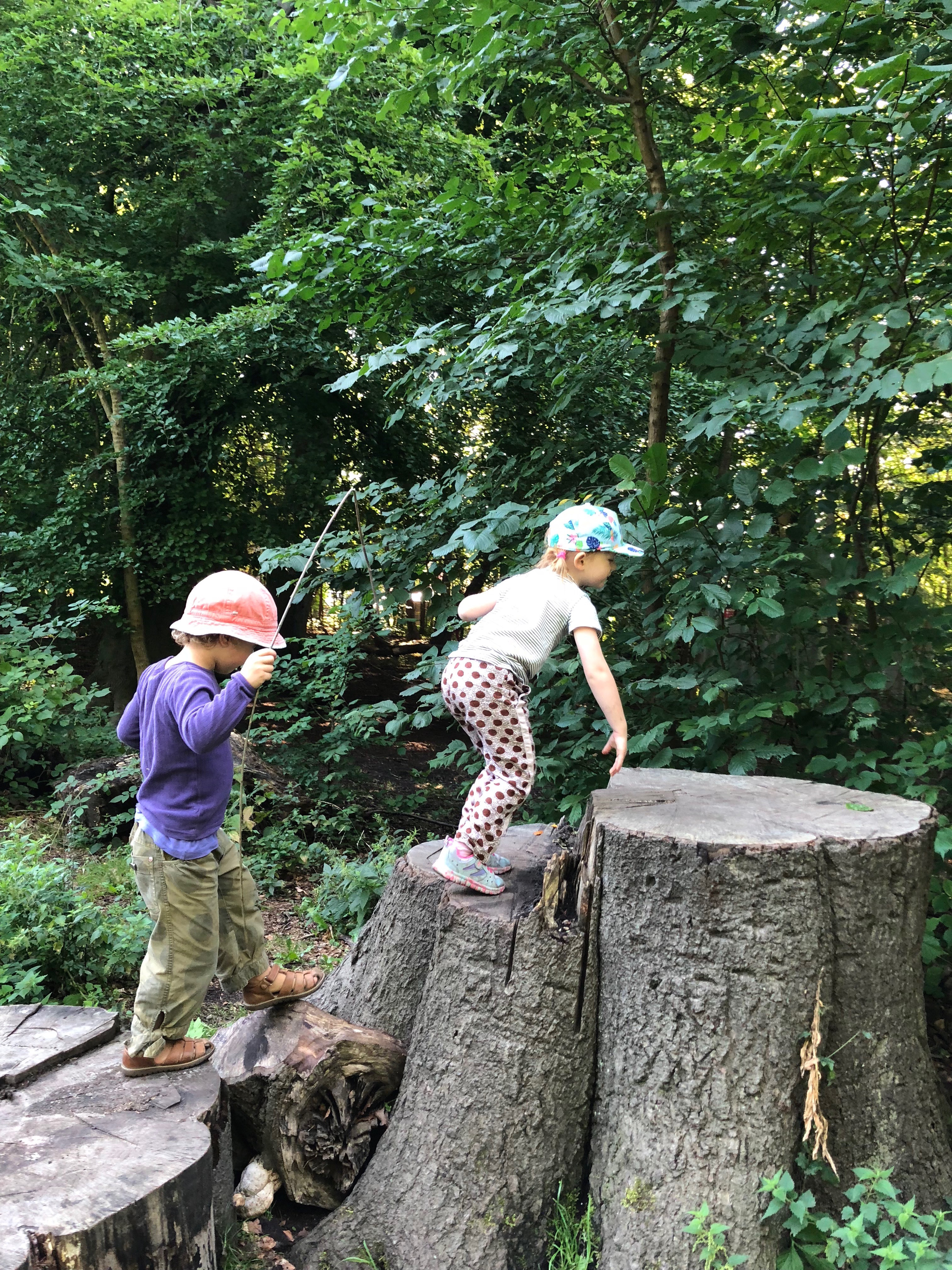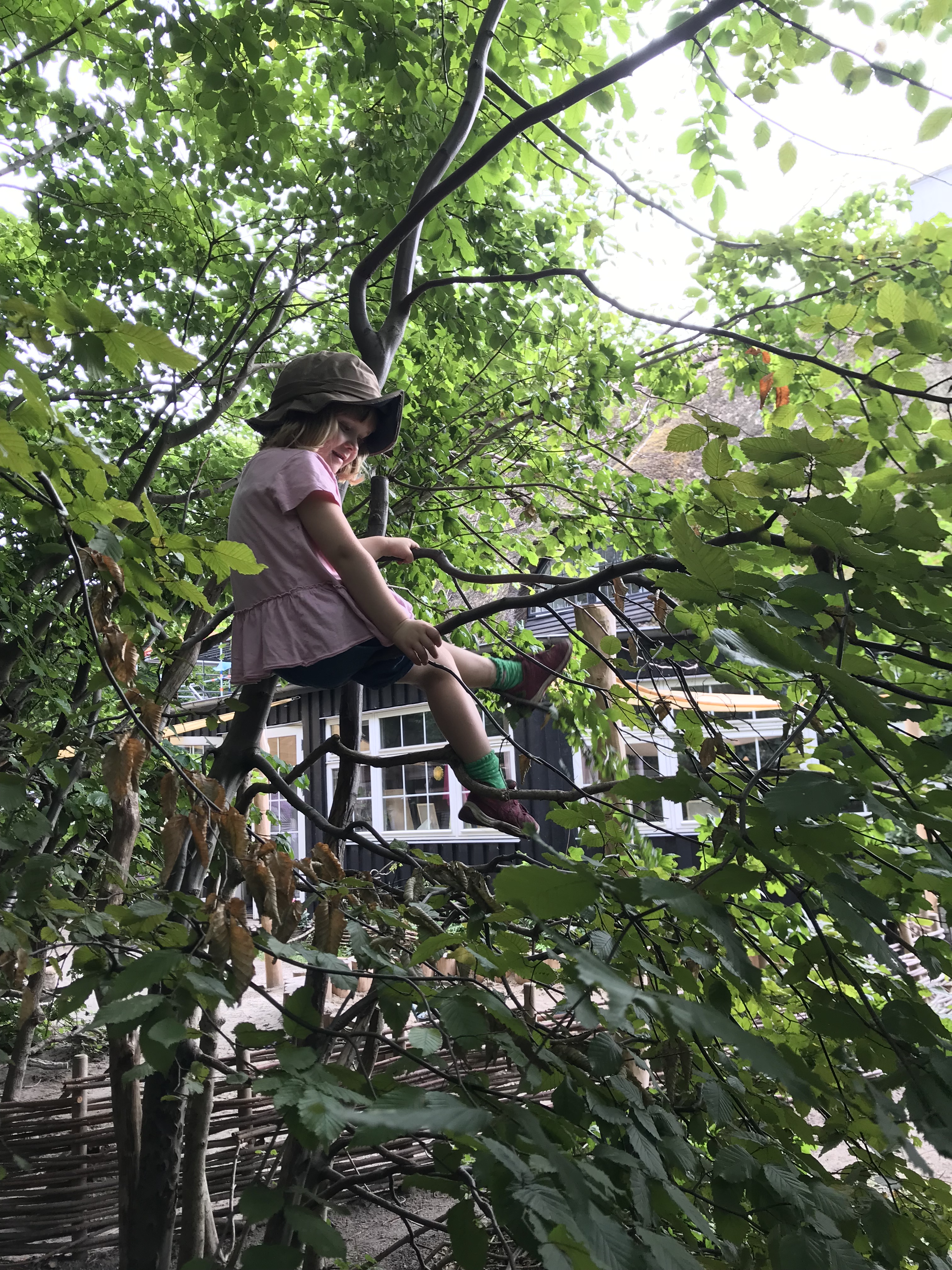Rikke Rosengren is the Director and co-founder of Bonsai, a Waldorf education house, forest kindergarten and nurserey. Rikke has a professional education as a kindergarten teacher, specialising in Waldorf education, and has worked and tought in the field of many years, as well as having published several books.
This book evolves around the importance of nature as a healthy and stimulating environment for children’s development. Nature has a unique potential as a platform for children to grow and experiment. The book emphasizes the immanent curiosity of the child and its natural need for movement and how we can optimize the conditions for children’s development outdoors. The possibility of both risky play and sensuous stimulation that nature provides for us, supports the health-promoting pedagogical foundation that is necessary for the healthy development of the child.
Rikke Rosengren at the conference “children of nature worldwide hand in hand” in Zurich, presenting her book “Child of nature
The book is relevant for parents and professionals as well as others that might have an interest in the multiple ways in which nature benefits human development.
Infothek Waldkinder: Denmark is the cradle of forest kindergartens. Therefore we are especially happy to do the interview with you, dear Rikke. You were also with us at the conference in Zurich. How did you like the conference and what impressions did you take with you?
Rikke Rosengren: It was great to come to Zurich for the conference and to see the wonderful support for the arrangement. I particularly enjoyed the group work, and the way you managed to hold all arrangements outside, in nature, in spite of the troublemaking weather. Should you consider repeating the conference in the future I would like to make a suggestion : Invite a speaker on an interesting and relevant topic to make a speak for all participants as one of the opening sessions. That way you bring the group together and create a common platform for all participants.
I clearly felt that nature was the right environment for children…
The first time you came into contact with early childhood education was in 1994 in Sidney, Australia. Since then, 25 years have passed in which you have been able to expand your expertise and implement remarkable projects in Denmark and internationally. How would you describe your last quarter of a century if you and I sat together in a cable car for 2 minutes and went up the mountain?

I always knew that I wanted to work with people/humans, and particularly with children. When I became a mother myself it became obvious that I has to start something myself, there was lacking good nurseries in Copenhagen. Once I had started a nursery parents of the children soon started asking for a kindergarten for their toddlers. It felt wrong to create a kindergarten in the urban city for me, and I started looking on the outskirts of the city. It was important that it was in a distance no longer than that it would be possible to bring kids from the city out into nature. I clearly felt that nature was the right environment for children. Today my work is also about educating my staff so they feel safe and comfortable in nature and able to act as good role models for the kids in the environment, as well as securing that parents feel safe about leaving their kids to be out in nature all day long. Through the years I have gathered all this experience and lately I was encouraged to write the book, where I describe how we work in our kindergarten, and why we choose to do as we do.

Besides some other books, a vegetarian cookbook, a songbook and a storybook, in 2018 you published the book “Child of nature”. What does your book emphasize and who did you write it for?
The book is meant for professionals as well as for parents. From experience I now know that children who have spent their childhood in our forest kindergarten still have a strong relation to nature, and tell stories of how important having an everyday life in nature was to them as small kids.
Imagine a person, an organisation or an entire country at the very beginning with the idea of going out into nature with children and working with them outside in nature. What important attitude do you think it takes for the accompanying person, for the organisation and for the country to be out in nature with people and to work with them?
A natural desire and an inner motivation. And some clear agreements about the practical arrangements (clothing, meals, locations etc.). Children need to feel safe and comfortable in order to relax and grow, so giving them a recognisable rhythm that creates
Children have a natural flair for wonder…
predictability is absolutely necessary. When choosing nature as the framework for work with children/childcare you need to “fit” the pedagogy into the framework. Nature puts other demands to the pedagogical strategy than other locations – one size doesn’t fit all. What I find particularly important is to make space for natural wonder. Children have a natural flair for wonder. They look, and they wonder and they understand, or they ask. In order for this to happen they need time to play, free unstructured play out in nature. There is a tendency for grownups to intellectualize, to explain, to show and to create activities for learning when being out in nature. But what children need the most is time to play and time to experience nature in their own manner. What grownups rather should do is to

provide the children with good environments, also when being out in nature. Make sure the terrain is varied, get out in all seasons and in different kinds of weather, and make sure there is a good balance between free play and activities. When children spend time in nature in their childhood they grow a strong relation to nature that stays with them for the rest of their lives, and taking care of nature, climate and sustainability awareness becomes natural for them. At our kindergarten my staff often expresses that they love their work because they spend so much time outside. They feel there is freedom outside, and time to be present, less stress and less noise, the way I see it this is one of the health promoting effects of spending time in nature. This said, all practical arrangements including clothing, camps, etc in the outside environment needs to be in order for them to feel this way, otherwise they soon become drained.
When children spend time in nature in their childhood they grow a strong relation to nature that stays with them for the rest of their live…
What natural attitude do the children bring with them?
Joy of nature, they feel safe and “at home” in nature. Being in and growing up in nature grows selfworth, because nature enables them to unfold and from using their body to move around in a varied environment develops enjoyment of their body – they feel strong and competent. They also learn to take care of nature and develop love and respect for the nature and the earth.
What important role do the parents play?
The parents hold an important role, since we need their cooperation on a lot of practical issues such as clothing and in our instance timing in relation to the bus (the bus brings the children back and forth from the city to the forest kindergarten), which families have to adjust their timing to. Being away from their kids for the whole day demands a lot of trust from the parents, that their kids are fine and that it’s fine for them to be away from them. Parents need to
It’s important that the parents themselves have an interest in nature…
choose nature for their children, to see the importance of being in nature also for their children, and It’s important that the parents themselves have an interest in nature. Parents also need to show interest in their children’s joy and enthusiasm for nature. And to understand that when they pick up their kids after work the kids might not need to spend more hours outside on the playground, but rather need to come home, after they spent many hours outside.
How important is it for us humans to have daily contact with nature?
Nature on a daily basis is very important…
In nature we can recharge ourselves, nature has so many gifts for us. Urban life can be very stressful. In nature we find energy, recharge the batteries, and feel our selves. Nature on a daily basis is very important.

Nature, vegetation and cultures are so different on earth. You have experienced many different environments over the last 25 years. What do you think, can forest kindergartens be founded on all continents and countries of the world?
Absolutely. The prerequisite is that you know your nature, that you know what dangers nature may hold and that you show respect for this. In Australia, where I once worked, they have a lot of dangerous animals and insects around. But the kids weren’t afraid, because they knew how to act and what to look for. An awareness which enabled them not to be in fear. Grownups who work with children need some precautions and need not to demonstrate our fear. It’s a bit like moving around in traffic, there are some rules you need to follow and some precautions you need to take. It’s important to show respect for nature – it’s much bigger than us, and there is a natural change in nature which require us to be awake.
It’s important to show respect for nature – it’s much bigger than us, and there is a natural change in nature which require us to be awake…
You need to know what plants you can eat and which ones are poisonous. But what is most important is to get out in nature! Some places nature seems so far away, like in Tokyo and other big cities, but here parks and small green spaces can be an alternative. It would be wrong to say that forest kindergartens only can be in forests or in rural areas. I sometimes meet fear in parents because they believe nature is dangerous for their children. They fear bacteria in the sand box, or fear that the children become wet and dirty when they play outside in the rain, or that they can fall down and hurt themselves if they climb trees. The unfamiliar is often experienced as something dangerous. We need to find the right attitude and the right perception towards nature, and the right equipment (clothes etc) so we are equipped to go out and can spread

the word that nature isn’t dangerous for children, that on the contrary children need to be in nature and to use their bodies to run, jump and climb, and to meet unfamiliar bacteria – all of this makes them strong and resistant. In the end it’s also about finding the motivation and the will to make it possible. I heard about a kindergarten in Manhattan where they bought rain-suits for all the
We need to find the right attitude and the right perception towards nature…
kids and took them out into a park three metro stops away. You need to organize yourself to make it happen. There is a tendency today that out of fear that their children might hurt themselves parents wrap their kids in bubble wrap. It takes a lot of faith and an attitude from parents and teachers to let children fall and rise themselves without trying to help them all the time or prevent them from falling, but rather motivate them to use their own powers to raise their body.


Editorial management: Christoph Lang, Nadja Hillgruber
Editorial design and implementation: Nadja Hillgruber, http://www.infothek-waldkinder.org
Picture credits: Photography © Rikke Rosengren
The digital trade journal is in its 10th year of publication
